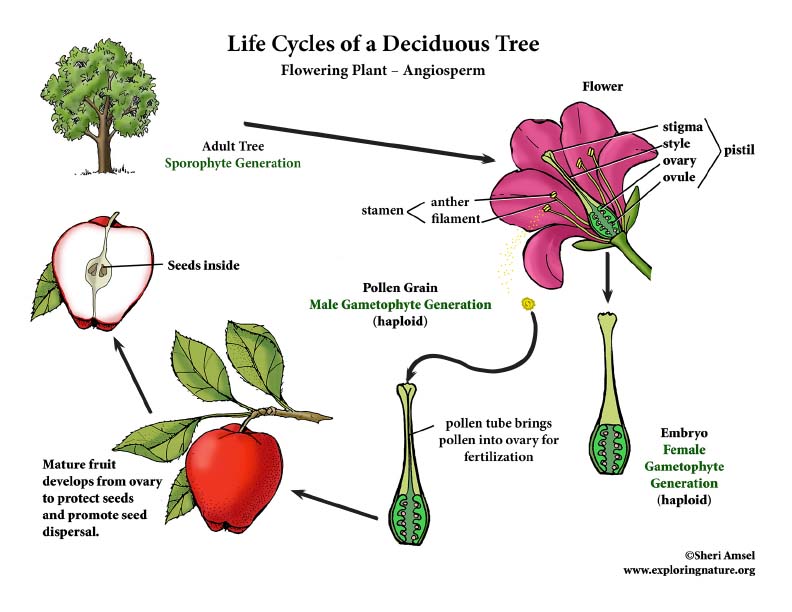

Trees are broken down into two groups, the gymnosperms (conifers) and the angiosperms (deciduous trees).
Deciduous trees (also called angiosperms) have seeds that are protected inside a fruit. They have vascular tissue bringing water and minerals from deep in the ground up to branches up to eighty feet high. These are hardwood trees.
Unlike gymnosperms, angiosperms have flowers. Inside their flowers are their male and female reproductive organs. The flower attracts pollinators: insects, bats and birds. Once pollinated, the flower develops seeds inside a protective fruit. The fruit can be fleshy, dry or highly adapted for dispersal. It protects the seeds and attracts animals that will carry the seeds away to grow elsewhere (seed dispersal).
Flowers petals can be large, colorful and showy to attract pollinators. Inside the petals is a ring of stamens - the male part of the flower that produces pollen. Each stamen is made up of a long, thin filament topped with a pollen-covered anther. The pollen is then transport by wind or animal pollinators to the female parts of the flowers. The stamens generally encircle the female part of the flower - the pistil. The pistil has three parts. The stigma is the sticky tip where pollen grains stick. The ovary is at the base of the pistil and contains the ovules. The style is the thin stalk that connects the stigma down to the ovary.
For older students: It is in the anther where the microspores develop into pollen grains. After the pollen grains land on the stigma, they grow pollen tubes down the style into the ovule. They each release two sperm into the ovule. One fertilizes the egg and the other fuses with other the divided polar nuclei to form the food for the developing seed, called endosperm. This double fertilization allows flowering plants to produce seeds that contain the embryo, food and a protective seed coat. The wall of the ovary then develops into a fruit that surrounds the seeds - the so-called covered seeds of the angiosperm.
When you research information you must cite the reference. Citing for websites is different from citing from books, magazines and periodicals. The style of citing shown here is from the MLA Style Citations (Modern Language Association).
When citing a WEBSITE the general format is as follows.
Author Last Name, First Name(s). "Title: Subtitle of Part of Web Page, if appropriate." Title: Subtitle: Section of Page if appropriate. Sponsoring/Publishing Agency, If Given. Additional significant descriptive information. Date of Electronic Publication or other Date, such as Last Updated. Day Month Year of access < URL >.
Amsel, Sheri. "About Deciduous Trees" Exploring Nature Educational Resource ©2005-2024. December 13, 2024
< http://www.exploringnature.org/db/view/About-Deciduous-Trees >
